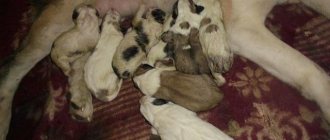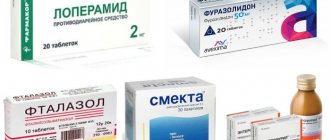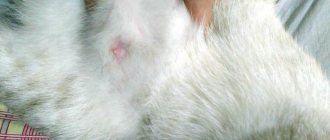We control the process
If you have a female dog and caring for puppies does not scare you, you will have to face the issues of pregnancy and childbirth of your pet.
Temperature in dogs before and after birth is the most important indicator of health and the normal course of labor. Therefore, when the time for the puppies approaches, you need to visit the bitch twice every day and record her. Provide this information to the veterinarian who will be present during the birth.
The temperature in dogs drops before giving birth. If normally it is 38.4-38.6 degrees, then about a day before the onset of contractions it drops and can be 37.4-36.6C and even 35C for representatives of small breeds.
Closer to the 60th day of pregnancy, you should not go away and leave your pet alone for a long time.
The first stage of the birth process is characterized by the presence of contractions. At this time, the woman in labor may experience shortness of breath and staggering when walking. Vomiting often occurs. The dog refuses to eat. This stage of labor can last up to 12 hours. In primigravidas, the period of contractions can last up to 35 hours.
Be sure to measure your temperature. If it remains low at this time, it means that the birth is proceeding normally.
During labor, the dog begins to show extreme anxiety. She may scratch the litter and become extremely agitated. Shortness of breath and vomiting persist.
During contractions, the vagina relaxes and the cervix dilates. The uterus itself periodically contracts, and towards the end of the first phase of labor these contractions become more frequent and more intense.
When the second phase begins, the rectal temperature rises to normal. The amniotic fluid leaves. The second stage can also be distinguished from the first by noticeable tension in the abdominal muscles. The cervix opens completely and the fetus enters the birth canal. The tense abdominal muscles contract strongly and frequently, pressure appears, and the puppy is finally pushed out.
A newborn puppy appears in a bubble. Often the mother ruptures the membranes on her own.
But some types of breeds cannot do this. In this case, you need to help burst the bubble, otherwise the newborn puppy will die.
After the birth of all puppies, all placentas should pass within 4-6 hours. Keep a close eye on their numbers, as the female usually eats them. If not all of the placenta has passed, be sure to contact your veterinarian.
During the postpartum period there should be no prolonged bleeding, the discharge should have a normal odor and there should be no pus in it. Rectal temperature should not exceed 39.5C. In all cases of deviation from the norm, as well as if the dog or puppies feel worse, urgent consultation with a doctor is necessary.
A dog's temperature most often changes after birth. If there is a lot of milk, then it can reach 39.5 degrees. Make sure that the temperature does not rise to 40C or higher - in combination with dark-colored discharge with an unpleasant odor, this symptom may indicate inflammation of the uterus. And lumps near the nipples can lead to...
Often lumps appear in the anterior nipples. When a few puppies are born, they suck from more convenient nipples, and in the rest the milk begins to stagnate. Try expressing milk from the hardened nipple or the one closest to the lump yourself. If that doesn’t work, you can give your pet no-shpa. After half an hour, inject oxytocin (0.5 ml) and try to express milk immediately.
If the temperature does not decrease and the lumps persist or even increase, consult a doctor.
All materials in the section " ".
A dog after giving birth is very vulnerable, which is why the owner simply needs to know what postpartum complications will be and how to alleviate the animal’s condition.
Eclampsia in a dog after birth
Eclampsia is an acute postpartum disease in which the content of ionized and total calcium in the blood sharply decreases, causing an imbalance of minerals. It is also called “milk fever”.
Characteristic symptoms:
- Nervousness, restlessness, increased arousal and activity.
- Loss of coordination of movements (ataxia), tetany (muscle spasms), convulsions.
- Vomit.
- Increased heart rate, breathing, temperature rise to 40-41 degrees due to central nervous system dysfunction.
Consequences of eclampsia: cerebral edema, cerebral hemorrhage, asphyxia, pulmonary edema, pneumonia, death.
The cause of eclampsia can be called the inability of the parathyroid glands to instantly correct the balance of calcium when the body needs it in significant quantities (for the formation of the bone apparatus of puppies, the generation of milk).
If your pet is expecting a large litter, but she herself is small in size, for example, if you have a Chihuahua, then you cannot relax; signs of eclampsia may appear even a few hours before the onset of labor. Often the disease occurs 3 days after birth, as well as at 2-4 weeks of lactation (puppies then consume the maximum amount of milk). You need to look after the female until the end of lactation.
Remember! If dangerous signs appear, provide first aid, otherwise the dog may die.
Warm the animal by wrapping it in a blanket and placing bottles filled with hot water.
Inject the pet intramuscularly with 10 ml of a 10% solution of calcium gluconate or the same dose of a solution of calcium borogluconate (10-20%). Introduce the dose slowly; this is a painful process for the animal. An alternative method is to administer calcium chloride - dilute 10 ml with milk and pour into the mouth. Calcium chloride cannot be injected; it causes tissue necrosis.
The next stage of resuscitation will be the intramuscular administration of sulfocamphocaine (cordiamine) in an amount of 1 ml. This will help excite the vasomotor and respiratory centers and stimulate the central nervous system. Instead, you can drop 5 drops of valerian or corvalol on your tongue. To maintain cardiac activity, you can inject magnesium sulfate intramuscularly.
The next step is to give a diphenhydramine tablet (inject 1 ml of diphenhydramine intramuscularly).
Check with your veterinarian in advance for the exact dosage for your pet and the need for these medications. Stock up on medications in a timely manner - after childbirth you will receive timely medical care, this will increase your chances of maintaining health.
Eclampsia can recur, so for ten days, inject 10% gluconate - approximately 10 ml, it is better to calculate accurately by multiplying 0.5-1.5 ml per kg of weight. If you can’t inject, feed your pet calcium chloride after meals (dilute 5 ml in milk). Do not forget to drip 5 drops of Corvalol (valerian) onto your tongue three times a day, do this 5 days after the attack. The veterinarian may prescribe prednisolone, vitamin D, and calcium lactate.
There is another way to combat severe eclampsia - transferring puppies to mixed or artificial feeding.
While the dog is carrying puppies, during lactation, provide the animal regularly with vitamin D, calcium supplements, and other vitamin and mineral complexes. What to feed your dog after giving birth
- the veterinarian will tell you.
Blood in a dog after giving birth
After giving birth, you may observe bleeding in your dog, depending on various reasons.
- Blood may flow due to a rupture of the external genitalia or perineum. These gaps occur due to untimely and/or unskilled obstetric care. During whelping, blood begins to flow and oozes for a long time.
- Bleeding occurs due to atony and hypotension of the uterus (due to decreased muscle tone). Causes of the pathology: polyhydramnios, a large number of fetuses in the uterus, prolonged labor, afterbirth remaining in the uterus. Blood accumulates in the horns of the uterus, and external bleeding is possible.
- Complete or incomplete uterine rupture causes bleeding. Causes of organ rupture: active labor, coinciding with a narrow pelvis and large size of the puppy; unreasonable use of oxytocin in the wrong dose (oxytocin stimulates labor). Signs of internal or external bleeding with a complete rupture may not appear fully or may be absent. During childbirth, with incomplete rupture, blood flows profusely from the loop.
- Coagulopathic bleeding is caused by a disorder of blood clotting and is rare. Causes of bleeding disorders: poisoning with hemolytic poisons (arsenic, lead, aniline), decreased platelet count, calcium deficiency.
Treatment options will depend on the type of bleeding. If the external genitalia are torn, the doctor will stitch it after the procedure. Other reasons may lead to the prescription of hemostatic drugs, stimulants, and antibiotics. Unsatisfactory treatment will result in a hysterectomy (surgery to remove the uterus). Urgent surgery is indicated for complete uterine rupture and bleeding of unknown origin. Coagulopathic varieties require complex therapy that treats the cause.
If you notice bloody discharge, do not think that your dog is in heat after giving birth.
. Estrus begins approximately 4 months after birth.
Discharge in a dog after childbirth
The causes of uterine inflammation called metritis can be a variety of microorganisms (Escherichia coli, Staphylococcus aureus, etc.) penetrating the vaginal mucosa and beyond (this is possible if antisepsis and asepsis during obstetrics are violated). Metritis occurs if a dead puppy or placenta remains inside (the last placenta); it is possible during prolonged and difficult labor, after which there is a low intensity of uterine bleeding. Inflammation develops due to poor hygiene of the whelping female, keeping her in unsuitable conditions, and hypothermia.
Manifestations of metritis:
1. Deterioration of appetite.
2. Depressive state.
3. Soreness and swelling of the loop.
4. Purulent gray-white discharge from the loop. If complicated, there is a putrid odor.
5. Increased heart rate.
6. Increase in temperature.
7. Dehydration, anorexia in a complicated form.
8. Decreased milk production.
9. Pain. You can notice by the unnatural pose of the animal - it sits in a crouched position, leaning on its elbows.
Have you noticed at least one symptom from the list? Contact your veterinarian immediately - without treatment, metritis ends in coma, then convulsions begin, leading to death.
A whelping female needs not only medical treatment, but also good care and special nutrition. For all puppies you need to find a wet nurse or transfer to artificial feeding.
To treat metritis, antihistamines, immunomodulatory drugs, antibiotics, and drugs that stimulate uterine contractility are prescribed. Detoxification and infusion measures are carried out. Complex therapy is the key to success.
In severe cases of metritis, the female is operated on to remove the primary source of infection; in the case of a septic form, such an event is doubtful.
In the first 2-3 days after birth, normal discharge is possible; it should not frighten the owner:
1. Black discharge without foreign putrefactive odor, lasting 1-2 days.
2. Green (transparent mucus with green specks).
3. Dark with green and brown tints.
Dog's temperature after birth
During lactation, inflammation of the mammary gland often occurs - mastitis. A variety of pathogens (Escherichia coli, staphylococci, streptococci) enter the milk ducts of the nipples and abrasions on the skin of the mammary gland. The development of mastitis is facilitated by stagnation of milk (with hyperlactation, a small number of puppies that do not suck all the milk, if the puppies do not use all nipples).
Symptoms of mastitis:
- Temperature increase
- Inflammation of the mammary gland, increase in volume
- Areas with compactions are palpated
- The appearance of pus with light pressure
Initiate therapy as soon as possible when symptoms appear. The veterinarian will prescribe a comprehensive treatment: antibiotics, painkillers, antihistamines, vitamins. Compresses with Vishnevsky ointment, camphor oil can be used; in case of intoxication, infusion therapy is indicated; massage, ultrasound, and UV irradiation will be useful. Surgery is possible for severe mastitis.
The dog is breathing quickly after giving birth
Dog breeders often notice that the dog is breathing after giving birth.
more frequently. Is this a complication? The female demonstrates rapid breathing during contraction of the uterus, during the process of milk formation, and under stress. But sometimes it can also be a terrible symptom.
The animal can overheat (in the summer, in a stuffy room), it does not have sweat glands, and the female will “cool down” in this way. Open the window slightly, ventilate the room, make sure there is no draft so that mother and offspring do not catch a cold.
Rapid breathing can also be caused by eclampsia, pulmonary edema, pneumonia, bronchitis, tracheitis, and pleurisy.
Why does a dog eat poorly after giving birth?
If a dog eats the placenta, it will refuse to eat for 5 hours after birth - this is normal. If the female continues to starve, then this is an alarming sign that may indicate, for example, eclampsia; urgently show your pet to the veterinarian. You cannot leave an animal without water and food; you will have to water and feed it by force. Give water and milk every 3 hours. You can add rehydron, calcium, and other mineral supplements to your food (a large loss of minerals occurs with milk), of course, after consulting a doctor. For 10 days, give up animal proteins, then you can introduce meat soups, broths, add finely chopped liver and heart, carrots, cabbage and other vegetables to porridges.
Experiencing serious stress during childbirth. Most often, the entire process of the birth of offspring takes place without any problems. However, it is not uncommon for a dog's health to deteriorate. Her breathing quickens, her body temperature rises, her appetite disappears, an unhealthy discharge appears, or other problems arise. Pet owners need to know what their dog may face after giving birth.
The first days after giving birth, the mother dog often experiences loose stools. Within one and a half to two weeks, bloody discharge from the vagina is possible. Over time, they become viscous and transparent. It is normal for a dog to have this kind of discharge after giving birth. There is no pathology here. During the postpartum period, the animal’s body recovers, which is why these changes are observed.
If bloody discharge from the dog’s uterus occurs before the birth of the first baby or in the intervals between the appearance of puppies, this is a cause for serious concern. In this case, you need to call a veterinarian.
A reason to consult a doctor is also the absence of discharge in the dog after birth or continuous discharge for 2-3 weeks. Discharge that has a strong putrid odor also requires calling a veterinarian. This should also be done if there is a heavy discharge of bright red color.
Estrus is another indicator by which you can judge the health of a dog. Dogs should go into heat after birth within 4-6 months. If this happens earlier, you should contact your veterinarian.
Pet owners should not confuse discharge with postpartum estrus in dogs. If some male dog on the street suddenly becomes interested in your recently given birth bitch, the reason for such interest is usually the smell, but the nature of the smell here is different.
It happens that a dog breathes frequently after giving birth. Owners need to monitor the animal very carefully. Rapid breathing after childbirth can have two causes.
In the first case, this is due to the fact that the dog’s uterus contracts and milk begins to be released. As a result, the animal begins to breathe rapidly, and this lasts approximately 5-15 minutes. However, the dog shows no external signs of illness. This state is considered natural. You can offer your dog water and not worry about your pet's increased breathing.
But there is a certain danger here. The reason your dog is breathing frequently after giving birth may be due to eclampsia. This is severe and requires immediate medical attention. Calcium is removed from the dog's body. Symptoms of emplaxia intensify. Therefore, the dog owner needs to call the veterinarian as quickly as possible.
An elevated temperature in a dog after birth is considered normal. But pet owners should measure the temperature in order to identify problems, if any, in time.
2-3 days after birth, the dog’s temperature can increase to 39.3-39.5 degrees. But if your pet’s temperature has exceeded 40 degrees, this is a reason to call a veterinarian. Self-medication is dangerous. Without special knowledge, you can only harm your dog.
A high temperature after birth indicates the presence of certain problems in the dog’s body. Only a specialist can make the correct diagnosis. Don't risk your animal's health.
Dog owners need to understand the golden rule: if your dog's condition after birth causes you concern, call the veterinarian.
Owners sometimes notice rapid breathing in their dogs. And there can be many reasons for this: from a normal physiological phenomenon to the manifestation of a disease or, even worse, the occurrence of a condition that threatens the pet’s life. Therefore, you should be aware of this pathology so as not to make mistakes and take timely measures.
Physiological increase in breathing in dogs
A dog's breathing is affected by many external factors. For example, heat. Under such conditions, the number of breaths can reach 160 beats per minute. Especially after active games, during physical activity.
A dog's breathing is affected by many factors, such as active play.
When restless or excited, the dog's breathing becomes faster. Breathing status is also affected by time. At night the dog breathes less frequently.
The character of the animal matters. Restless dogs with a mobile nervous system breathe more often.
Note! It's normal for a dog to have rapid breathing after giving birth! The bitch's uterus contracts and milk begins to secrete. In this case, the dog does not show symptoms of the disease
Why does it happen that a dog breathes quickly?
It has been established that in a calm state, our four-legged friends usually take 10-30 breaths per minute. But this value is conditional and depends on the size of the dog and its age. The breathing rhythm changes after significant physical activity, during long running, etc. This is especially typical for the hot season, when the frequency of breaths per minute can reach 160. The pet’s breathing will become faster due to overexcitement. The breathing rate is different and the animals are restless and have an unstable nervous system.
These are all normal physiological phenomena. But when rapid breathing occurs with minimal activity or even at rest, one should already think about pathology. In this case, it is useful to observe the animal. In a calm environment, the dog does not open its mouth when breathing and does not make any noise (of course, in the absence of a special structure of the muzzle, for example, like pugs, then pets not only sniffle, but also snore). There can be many reasons why a dog is breathing rapidly:
- cardiac pathologies;
- pulmonary diseases;
- unhealthy pulse;
- neoplasms in the respiratory tract or lungs;
- pneumonia due to an infectious lesion of the body;
- obstruction of the respiratory tract;
- injury accompanied by bleeding into the chest or accumulation of fluid in it, etc.
When your pet begins to breathe faster for no good reason, it means that he should be taken to the veterinary clinic. After all, this already predominantly indicates the presence of a pathological condition, which must be identified in order to provide qualified assistance.
The dog breathes frequently with its mouth open: possible causes and treatment features
Many dog owners sometimes notice that their dog is breathing rapidly. This can be considered a completely normal phenomenon, but it can also indicate serious illness. To determine what this is connected with, it is necessary to take into account some features. The normal breathing rate for dogs is 10-30 breaths per minute. To determine the number of breaths, you need to place your hand on your pet’s chest and time it for one minute.
We recommend reading: Why the Cat Pushes with its Paws
Your dog's breathing may change frequently throughout the day. If nothing bothers the pet, then he breathes through his nose and calmly. But if the dog does this with his mouth, then this action is not always a cause for concern.
Symptoms of rapid breathing and heartbeat
With rapid breathing caused by malaise, changes in the animal's behavior are immediately noticeable. It can be:
- restless behavior, trembling;
- cough, shortness of breath, hoarseness;
- blue gums;
- reluctance to eat;
- vomiting, diarrhea.
Moreover, if the dog has rapid breathing and heartbeat, as well as trembling, it is almost impossible not to see all this. When a pet exhibits disorientation, it is most likely to suffer from heatstroke. He should be placed in a cool place, given a drink, and a wet towel applied to his head.
A bluish tint to the tongue and fainting can occur with heart problems. In this case, the animal should be well covered, warm heating pads should be applied to its paws, a veterinarian should be called to the house, and before his arrival, Cordiamine should be administered intramuscularly. But the presence of a whole set of the above symptoms should be a particular cause for concern. In this case, a visit to an experienced veterinarian is mandatory, because this is exactly the case when, as they say, delay is like death.
Diagnosis of rapid breathing in a dog
First you need to exclude external factors: stress, heat, anxiety. After this, take the animal to the clinic. It is important to create peace and comfort for the dog. But don't overdo it! Do not try to force water on an animal, it can be dangerous. You wish him well, but a sick and frightened dog can behave unexpectedly.
At the veterinarian
If a dog has difficulty breathing, then the main task is to supply oxygen.
This is done using an oxygen mask or placing the animal in an oxygen chamber.
At the same time, the veterinarian will begin an examination - listen to the heart, measure the pulse. To identify the causes, the veterinarian conducts a series of studies.
To identify the cause, use:
- X-ray (exclusion of a foreign body in the respiratory tract and tumor)
- Electrocardiogram
- Ultrasound of the heart
- A general and biochemical blood test is required
Emergency help for rapid breathing
But it happens that the pet’s condition worsens, and it is not possible to transport it immediately to a veterinary clinic. Then the owner himself should provide first aid. First of all, the animal should be given complete rest. Place it in a separate room or in a quiet, cool corner. Try to ventilate the room to ensure a flow of fresh air.
But at the same time, there is no need to force him to settle, nor do you need to force him to drink a lot. After all, you can only make the situation worse. Having created such conditions, you need to take care to call a veterinarian at home. And before he arrives, you should under no circumstances give your pet any medications. After all, this can only complicate the further process of therapy.
But it’s best to try to deliver the dog to the clinic yourself, in order not to waste precious time. Here, different treatment methods will be used to make an accurate diagnosis, and there is everything to take urgent measures if something happens. So, a special mask is used to saturate the dog’s body with oxygen. And if such a measure does not have the desired effect, surgical intervention may be performed.
Specifics of dog treatment
Animal lovers should always remember that when a dog has rapid breathing, this is not an independent illness. Dyspnea is usually a clinical sign of the disease. It is quite clear that a course of therapy in this case is prescribed only after the cause of such pathology has been identified.
If the airway is obstructed, the doctor will remove the foreign object, perform artificial ventilation, or resort to tracheal intubation. When such a condition is associated with cardiac dysfunction, special therapy is indicated. For problems with the lungs, anti-inflammatory drugs and diuretics will be used for treatment.
In general, the therapeutic effect in identifying the causes of this complex pathology involves the following actions:
- hospitalization if necessary, keep the dog under an oxygen mask;
- prescribing medications to reduce stress;
- removing fluid between the lungs and the chest wall using a special thin needle;
- the use of diuretics - even ordinary Furosemide will have its due
- exposure to severe pulmonary edema;
- when necessary, use of drugs to support the heart.
Therapy at home
Hospitalization is carried out when there is an immediate threat to the life of the animal. In other cases, dogs are treated at home. For home therapy to be successful, owners of sick pets must adhere to certain recommendations:
- do not prevent the dog from drinking water - the administration of the same Furosemide can lead to dehydration of the animal’s body;
- do not violate the recommendations and instructions of the veterinarian - bring your pet for examination as often as you can;
- never buy, or even give your dog, medications that have not been prescribed by a doctor - the consequences of such independence can be very disastrous.
When your pet develops rapid breathing after sterilization or other surgical intervention, do not hesitate to consult a veterinarian about this - this may be a consequence of anesthesia, or it may be the first sign of any complication.
Types of shortness of breath and their characteristic features
During significant physical exertion, the animal has to open its mouth wide, which allows it to quickly restore the functionality of its body and compensate for the loss of energy. Rapid breathing after a walk with running and frequent jumping is a completely normal phenomenon that should not cause concern. But cases when it occurs in a calm state are classified as symptomatic manifestations and should alert the owner.
In this situation, the most important thing is the current state of the cardiovascular and respiratory systems. When examining a dog or puppy, it is necessary to determine the nature of its breathing, for which you should learn to distinguish between concepts such as expiration and inspiration.
Expiration refers to the phenomenon of breathing in the form of short inhalations and long and very heavy exhalations, which are often incomplete. At the same time, unpleasant wheezing or muffled snoring may occur. All these sounds indicate a partial narrowing of the lower bronchial region due to asthma or bronchitis.
The inspiratory form of breathing involves either sharp short or heavy prolonged breaths, which can occur due to swelling of the respiratory tract, as well as after receiving minor injuries or getting foreign objects into them.
The mixed type of respiratory activity refers to particularly acute conditions in which both inhalation and exhalation are difficult; Moreover, all attempts to breathe normally are accompanied by strangled wheezing and coughing with spasms.
Prevention of illness
Compliance with the rules and regulations for keeping him will help prevent the development of such a pathology in your four-legged friend. For example, lung diseases, as a rule, arise due to an infectious lesion of the body and it does not matter whether it is a direct pathology or the result of a complication of another ailment.
Therefore, protecting your pet from infectious agents is the main principle of preventing respiratory diseases. Therefore, it is always important: to adhere to regular examination of the pet, both by the owner himself (identifying various changes), and clinically, which will determine the pathology if something happens; at the slightest suspicion, perform an analysis for infectious lesions;
- do not refuse preventive vaccinations against diseases common in the region;
- once a quarter, and in the summer much more often, treat against helminths.
Creating optimal conditions for keeping a pet is considered equally important. After all, inflammation of the respiratory system more often occurs in dogs that are kept in drafts, in cold, damp rooms. In this case, in the fall, especially their guard breeds, begin to cough heavily.
Spring is no less dangerous for animals, when allergic reactions can worsen against the background of plant pollen or poplar fluff. So if rapid breathing occurs in dogs, the causes should be looked for immediately and try to eliminate them. But when the owner himself cannot solve the problem, there is a reason to immediately seek veterinary help. It is important to always remember that there is no serious canine pathology that causes wheezing that can be treated at home.
What do you prefer to feed your pets?
Poll Options are limited because JavaScript is disabled in your browser.
A successful birth of a dog is a joy for both the new mother and the owner who watches the touching squeaking puppies. Unfortunately, the birth of cubs does not always end happily: childbirth in dogs can lead to the development of complications, many of which are very dangerous for the health of both the female herself and all her offspring.
In general, in cases where the dog gave birth quickly, without experiencing any difficulties, no complications should be expected, since the prerequisites for their development are simply absent. If your pet feeds the puppies, cares for them, and the babies do not show any signs of anxiety, then everything is probably fine. Moreover, many manifestations of “diseases”, as they are perceived by inexperienced breeders, upon closer examination do not indicate anything serious.
Of course, you shouldn’t “relax” completely, since some types of postpartum complications can appear several days or even weeks after birth. Some of them (eclampsia, for example) can develop within a couple of hours, and if help is not provided, the case will most likely end in death. To avoid such sad consequences, we advise you to make it a rule to watch your pet and puppies for at least an hour a day.
First, we will discuss signs that are equally likely to indicate some complications or be the norm. But how can one distinguish pathology from physiological phenomena characteristic of the body of a recently given birth dog? The answer is simple - if you categorically do not like something in the behavior or appearance, immediately call the veterinarian.
In any case, a preventative examination by a specialist will not hurt an animal during the postpartum period.
Ignoring food and water as the first symptom of complications
After the dog's labor is over, the owner can breathe a sigh of relief and relax a little. If the puppies are active, eat well, and the young mother takes care of the offspring, we can say that the most difficult stage is over. However, you will have to be attentive for at least two more days, since the mother and her offspring are under threat.
Inexperienced owners often hope for luck, believing that their pet is healthy and will not have complications. Even the strongest, youngest and healthiest dogs are not immune from postpartum complications.
Note! Statistically, postpartum complications are more common in small and miniature breed dogs.
Even if you are sure that the birth took place without complications, you must invite a veterinarian within 48 hours after the babies are born. The doctor will examine the young mother and assess her condition. In addition, a veterinarian should examine the offspring. Common postpartum complications can occur within hours or even days. Unfortunately, almost all of them give acute symptoms and a dangerous clinical picture. The owner does not have much time to provide assistance, and if there is delay, even the veterinarian may be powerless.
Should I be concerned if a dog who recently gave birth refuses to eat? It is quite normal for a new mother to refuse food for 2-5 hours after giving birth. There are several reasons for this behavior: the dog is tired, overworked, has experienced severe stress and pain, wants to sleep and desperately wants to take care of the offspring. In addition, during the birth process, the dog instinctively eats the puppies' placenta, which helps compensate for the loss of nutrients and trace elements.
Normally, it is believed that a dog that has given birth to puppies should start eating within 24 hours. Usually, when a young mother decides to eat, she finds herself very hungry. The owner needs to be prudent and not overfeed her. It is better to feed your dog often, but little by little.
Hunger that lasts more than 24 hours after the birth of the last puppy indicates postpartum complications. It is difficult to determine exactly what problem you are dealing with.
Important! Even if the dog does not eat after giving birth, it should continue to drink. Moreover, after the end of childbirth, the dog drinks greedily and a lot. If your pet ignores the water bowl, be sure to contact your veterinarian!
The dog doesn't go potty
How dangerous is this? Some first-time dogs are so “amazed” and attached to the puppies that they even forget to eat or go to the toilet, holding out until the last moment. If the reason is precisely your reluctance to leave the puppies, you can help your pet take a little break from the company of your babies.
A simple tip - if you put an infrared heating pad under the bed with the puppies, the babies, once warmed up, will sleep much longer.
In the first days, the cubs become very nervous if they talk loudly nearby, slam doors, or simply walk around frequently. So you shouldn’t start home renovations at this time: wait until the puppies grow up and become “morally stronger.”
The problem is that constant stress and irregular nutrition (as well as the consequences of compression of the intestines by the swollen uterus) may well cause severe pain in the dog. What can you do? The easiest way to deal with constipation is to regularly feed your dog food rich in dietary fiber.
Pumpkin puree is ideal for this purpose. Two or three tablespoons at each feeding is enough to forget about constipation in your dog. True, we would not recommend practicing a pumpkin diet for more than five days, as some dogs may develop.
Poor appetite
How normal/abnormal is decreased appetite immediately after childbirth? In the first hours or even days after the birth of kittens, a dog (especially a primiparous one) may be too tired and exhausted to eat much and with appetite. Please also note that during a normal birth, the dog usually eats all the placentas (placentas) of the puppies, so she is not particularly hungry in any case.
You should not expect the return of a full appetite earlier than a day after the puppies are born.
Most likely, by that time your pet will be very hungry and will eat with appetite.
Note that at this time the dog’s body must provide not only its own needs, but also the needs of the puppies. Therefore, it is necessary to feed the bitch who has given birth with balanced, complete food. Otherwise, the body of the puppies and the mother herself will not receive all the necessary nutrients, micro- and macroelements, and therefore the development of severe pathologies of nutritional origin is possible. Ideally, you should use a diet developed by an experienced veterinary nutritionist, or special commercial foods designed for feeding postpartum dogs.
We remind you once again that food and drink, at least in the first days, should be placed directly next to the “den” with the puppies.
In what cases should you seek help from a veterinarian? As a rule, the need for this arises if a day or more has passed since the birth, but your pet still has no appetite. This often happens when the placenta is retained. The placental membranes remaining in the uterus begin to rot, and lack of appetite is a sign of severe intoxication of the dog’s body.
Postpartum shortness of breath
What if, after giving birth, the dog sits for a long time with its mouth slightly open and breathes deeply and frequently? Shortness of breath is normal during the first day after the puppies are born.
. Firstly, the animal may be very tired. Secondly, at this time the dog often experiences mild hyperthermia (many puppies + maternity “den” = stuffiness).
In addition, postpartum shortness of breath in dogs is often associated... with puppies that intensively suck milk from their mother. Mechanical stimulation of the nipples causes an abundant release of hormones, the action of which can actually cause shortness of breath in the animal.
In what cases can increased breathing be considered a pathology? As in the previous case, we recommend consulting a veterinarian
if the intensity of shortness of breath does not decrease, even a day after birth.
In such situations, breathing problems can also be caused by the presence of a retained placenta or pathologies of the cardiovascular system, aggravated during childbirth.
In addition, shortness of breath may be the first symptom of incipient eclampsia or infection.
(which is especially important if the animal’s overall body temperature is elevated).
Postpartum period in a dog
In the first days after giving birth, the female dog has a slightly elevated temperature, increased breathing and pulse, and decreased blood pressure. At this time, the animal’s uterus regains its normal shape and size.
Normalization of internal processes is accompanied by stabilization of the shape and size of the abdomen, and the return of the normal appearance of the vulva. In the first ten days after birth, the compaction of the pelvic ligaments also resolves and swelling occurs. Within two weeks, the old integumentary epithelium of the uterine mucosa is completely exfoliated and leaves the body, and the cervix is completely closed.
We recommend reading: What is the Best Rabies Vaccination?
Discharge from the external genitalia
Perhaps this is the most “slippery” case, since at home it is not always possible to distinguish pathological discharge from discharge, the appearance of which is due to completely normal physiological processes.
Within three weeks, the vagina of a dog that has given birth may discharge copious amounts of “streaks.”
, which are scientifically called lochia. This is absolutely normal. What causes panic among breeders is the fact that this discharge may have a greenish, brownish or even black tint.
But! During the normal postpartum process, they should not have an unpleasant odor.
In addition, constant watery discharge in the first hours after birth is dangerous, as they often indicate the placenta remaining in the uterine cavity. Bloody discharge, the volume of which varies little over time, can partly be explained by the normal process of uterine involution (i.e., the return of the normal size of the organ), but they can contribute to the development of anemia. Thus, discharge may well indicate complications after childbirth.
Breathing problems - norms and pathologies
Within a few hours after giving birth, the new mother feels very tired. Against the backdrop of a likely refusal to eat, the degree of fatigue only gets worse. In addition, the young mother experiences significant discomfort. Against the background of painful sensations in the abdomen, puppies sucking milk can provoke hot flashes. In this case, the dog begins to breathe with its mouth open.
Note! When puppies suckle, they stimulate the uterus to cleanse and contract, which can cause additional tension in the peritoneum. During contractions, the dog may breathe heavily - this is normal.
The owner should immediately contact a veterinarian if breathing problems lead to obvious oxygen deprivation. Intense breathing with an open mouth can be triggered by an increase in base body temperature. Unfortunately, fever in the postpartum period indicates serious complications: the development of an inflammatory process, an infectious lesion or postpartum eclampsia.











